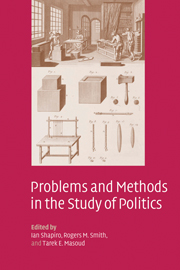Book contents
- Frontmatter
- Contents
- List of contributors
- Acknowledgments
- 1 Introduction: problems and methods in the study of politics
- Part I Description, explanation, and agency
- Part II Redeeming rational choice theory?
- Part III Possibilities for pluralism and convergence
- 12 The illusion of learning from observational research
- 13 Concepts and commitments in the study of democracy
- 14 Problems chasing methods or methods chasing problems? Research communities, constrained pluralism, and the role of eclecticism
- 15 Method, problem, faith
- 16 Provisionalism in the study of politics
- 17 What have we learned?
- Index
- References
12 - The illusion of learning from observational research
Published online by Cambridge University Press: 22 September 2009
- Frontmatter
- Contents
- List of contributors
- Acknowledgments
- 1 Introduction: problems and methods in the study of politics
- Part I Description, explanation, and agency
- Part II Redeeming rational choice theory?
- Part III Possibilities for pluralism and convergence
- 12 The illusion of learning from observational research
- 13 Concepts and commitments in the study of democracy
- 14 Problems chasing methods or methods chasing problems? Research communities, constrained pluralism, and the role of eclecticism
- 15 Method, problem, faith
- 16 Provisionalism in the study of politics
- 17 What have we learned?
- Index
- References
Summary
Introduction
Empirical studies of cause and effect in social science may be divided into two broad categories, experimental and observational. In the former, individuals or groups are randomly assigned to treatment and control conditions. Most experimental research takes place in a laboratory environment and involves student participants, but several noteworthy studies have been conducted in real-world settings, such as schools (Howell and Peterson 2002), police precincts (Sherman and Rogan 1995), public housing projects (Katz, Kling, and Liebman 2001), and voting wards (Gerber and Green 2000). The experimental category also encompasses research that examines the consequences of randomization performed by administrative agencies, such as the military draft (Angrist 1990), gambling lotteries (Imbens, Rubin, and Sacerdote 2001), random assignment of judges to cases (Berube 2002), and random audits of tax returns (Slemrod, Blumenthal, and Christian 2001). The aim of experimental research is to examine the effects of random variation in one or more independent variables.
Observational research, too, examines the effects of variation in a set of independent variables, but this variation is not generated through randomization procedures. In observational studies, the data generation process by which the independent variables arise is unknown to the researcher. To estimate the parameters that govern cause and effect, the analyst of observational data must make several strong assumptions about the statistical relationship between observed and unobserved causes of the dependent variable (Achen 1986; King, Keohane, and Verba 1994). To the extent that these assumptions are unwarranted, parameter estimates will be biased.
Information
- Type
- Chapter
- Information
- Problems and Methods in the Study of Politics , pp. 251 - 273Publisher: Cambridge University PressPrint publication year: 2004
References
Accessibility standard: Unknown
Why this information is here
This section outlines the accessibility features of this content - including support for screen readers, full keyboard navigation and high-contrast display options. This may not be relevant for you.Accessibility Information
- 37
- Cited by
